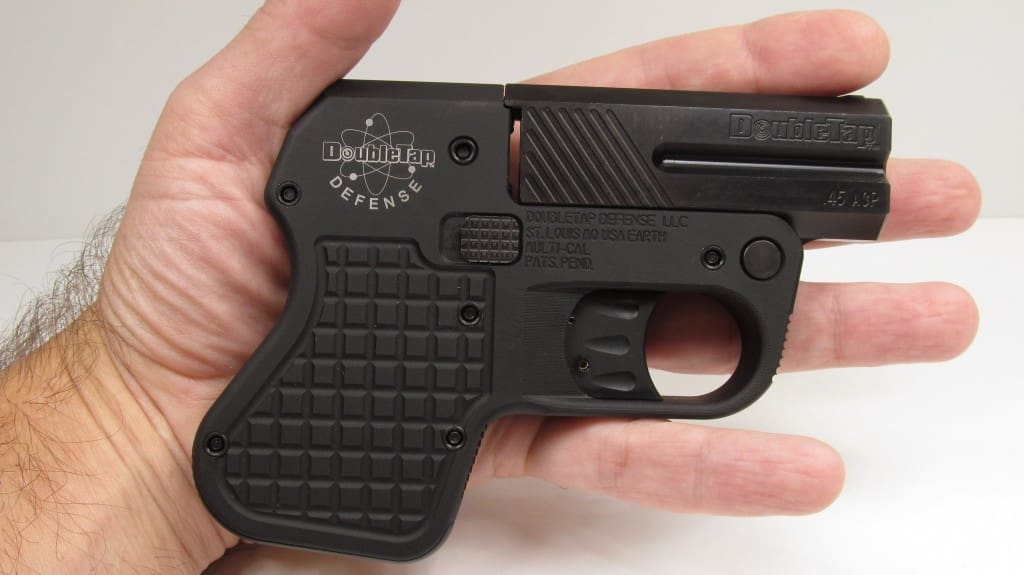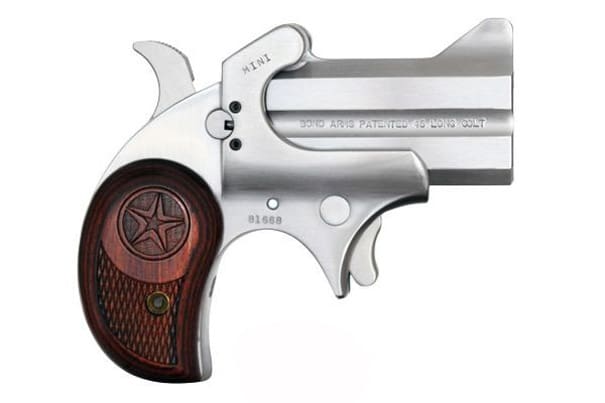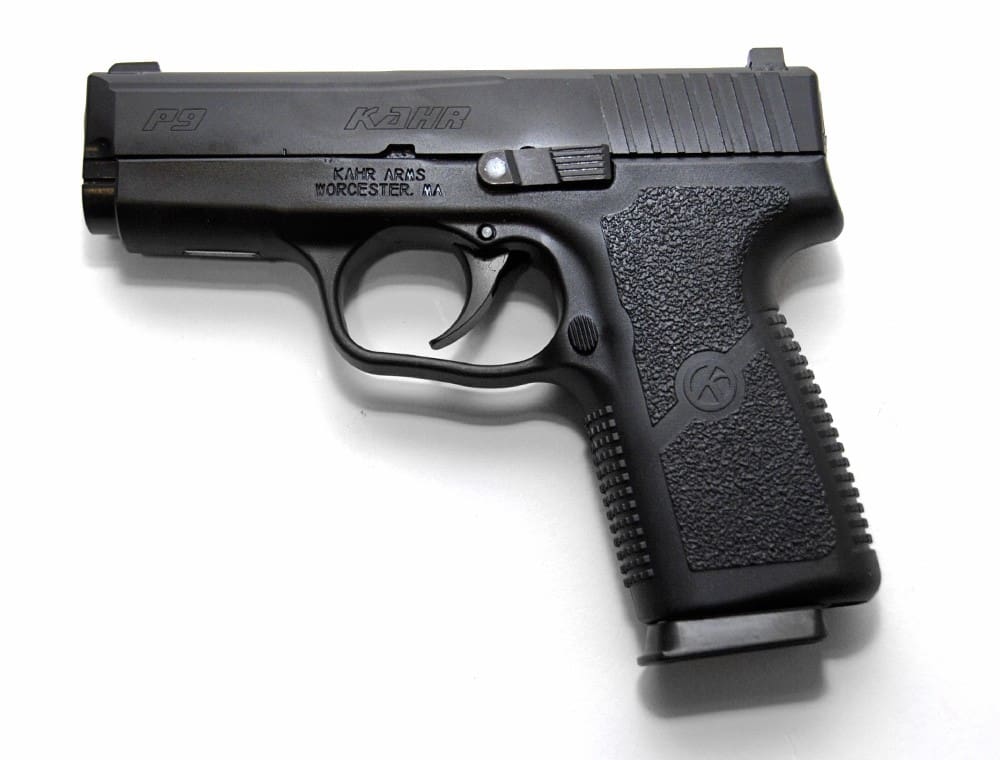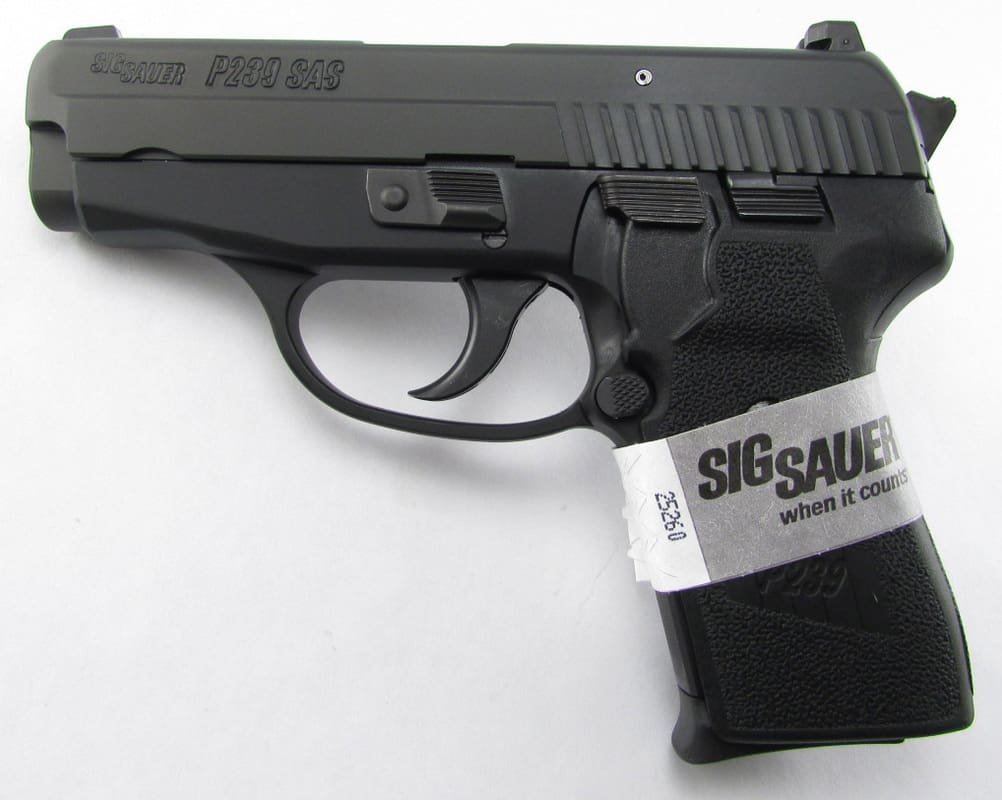
By Constantine via concealednation.org
Concealed Nation emphasizes the importance of carrying every day. We learn from news accounts that an emergency can arise at any time. You can be at home watching TV, driving in your car, walking your dog or taking out the trash. Your defensive handgun cannot help you if you do not have it with you when the trouble starts. You will not have your gun with you if carry has not become a habit, or carrying is difficult or extremely inconvenient . . .
Many beginners in concealed carry, especially those with little or no experience with handguns, may think that the smaller and lighter the firearm, the better. This is not true. This example is an extreme case, but it illustrates a point very well.
The Double Tap Defense .45 ACP in the review malfunctioned, setting off TWO rounds of .45 ACP simultaneously. Even if the gun had functioned normally, firing a full-power .45 ACP round in a 15 oz. gun which is only 0.665″ wide is going to leave a definite impression on your hand! Something tells me that practice sessions with this gun would be very brief.
Selecting a handgun for concealed carry is an extremely personal thing. The only person who can do it is you. Too often, a well-meaning fellow will give his wife, daughter, or girlfriend a tiny .380 auto or a S&W J-frame, thinking that the small size and light weight will appeal to the lady. In fact, these small guns are better for experts than for beginners. A nice “compact” pistol in 9mm or a 4″ .38 Special revolver may be easier to control, provide a better fit to the hand, and inspire more confidence.

There a number of factors to consider in choosing your concealed carry piece. Trade-offs exist among some of them. You need to select the combination which fits you the best. Often, the only way to decide is by test-firing several guns at a rental range or in a training session. In fact, it is a great idea to get some professional training before buying your first handgun. Most instructors have lots of guns and will be glad to let you try them out.
Above all, please keep the following requirements in mind:
- Reliability The gun must fire without fail every time the trigger is pulled.
- Controllability You must be able to place the first round on the target as quickly as possible, even when under high stress.
- Power The round must be able to do enough damage to the target to stop any hostile action. In many cases, multiple shots may be necessary.
- Concealability You must be able to carry your firearm all day, every day. It must be concealed, yet always ready for use in an emergency.

The first requirement is absolutely non-negotiable. The other three offer some room for give and take among them. You want to carry the most powerful firearm you can control reliably and carry with confidence. Overall size and weight come into the equation, but just as important is how the gun feels in your hand.
Only you can judge this. It depends on the height, angle, shape, and thickness of the grip. The ability to place successive shots on target in rapid fire is also important. If the .45 ACP or .44 Special has too much recoil, try a .40 S&W or a 9 mm. Also, remember that training and regular practice will help build and maintain your shooting skill.

As far as size and weight go, they are what comes out after you have made all the other choices. If you are committed, you will train and dress appropriately for the firearm you choose to carry and the environment in which you carry. Do not always go for the smallest and lightest firearm. Your hand will thank you. Stay safe.




There are two other factors that seldom get mentioned in picking a concealed carry pistol — Ammunition choice and sight radius.
No need to discuss the problem of finding the right ammunition that will properly in a 3″ barrel since we have on ongoing series. Sight radius is much overlooked in discussing concealed carry pistol choice. It may be true that most DGUs occur at close range but many would surprised how easy it is to miss the target. Having a longer sight radius improves accuracy. I am far more accurate with my Springfield Compact than I am with my Nano at any range. At self defense ranges — 10 yards or less — I am generally 100% in the Q-bottle on the FBI target. The groups are much tighter as well. Since one and done is rare repeatability is an important attribute.
The Compact pistol is the ideal size for conceal carry. They have longer barrels and sight radii, good capacity and they are still very concealable. If you can’t carry 25 ounces all day then you re in terrible shape. If you only have one gun for personal defense that gun should be a compact.
Having to buy new clothes to carry a double stack compact to subcompact size handgun is a bigger issue. Single stack sub-compacts generally don’t. As far as weight goes, its about comfort, not ability to carry the weight.
One other factor: an effective, comfortable holster.
I have heard the clothes thing before. I was standing at a gun store while the salesman was telling a customer this very thing. I had trouble keeping a straight face because I was carrying a full sized 1911. If you have adult clothes you can comfortably corneal any sized pistol
What? I think this depends on what we mean by “conceal”. Once I was working out at the Y and the guy on the treadmill in front of me had (I kid you not) a Desert Eagle tucked into the belt of his jeans. I saw it plain as day, out in the open. That’s not concealed carry. This also depends on your normal attire. If you can get away with wearing oversized clothing (hoodies, etc) to work, you’re ok. I think it also depends on your body frame – where you’ve got extra room and where you don’t. For me, I can’t conceal a full size 1911. I don’t know anyone that carries concealed that could/would.
Not if your clothes just fit. I carry a Ruger LC9s, and I have to go one size up in pants.
What happened to your BHP?
Still have it and still carry it. It’s my road trip pistol.
@tod
I have carried a 1911 in every type of clothing include suits. Normal summer casual attire is slacks and untucked LL Bean shirt. I do carry my Nano on the golf course because larger pistols interfere with my swing.
Respectfully, I can’t agree. What I have read of real handgun combat situations is that the defensive shooters rarely see the sights. This was also my experience having been a former competitive target shooter when I went to multiple FoF training classes. People miss at close range because they haven’t learned and don’t practice point shooting, not because their barrel isn’t long enough. Also, sighted shooting implies you are going to stand there and trade rounds. If you are shooting, you should be moving, making aimed fire even more problematic.
At longer ranges, say greater than 10 yards, the innovation of the laser sight makes point shooting viable out to even longer distances, although my plan is that if I am point shooting and moving already, my goal is going to be to evade, not stay in the fight.
Even in point and shoot situations you are looking down the barrel to get a sight line. the larger gun is still more accurate.
Just a personal observation, but my Wiley Clapp GP100 is about the same size, overall length, height, and loaded weight as my Beretta 92, but being a revolver it has a sight radius that’s about 3/4 that of the Beretta. Nevertheless the Ruger’s WAY more accurate, or perhaps more appropriately I can shoot way more accurately from a standing unsupported stance. I can hit a 12″ target at least 5 out of 6 with the revolver at 50 yards (again unsupported) and I’d be lucky to do that 40% with the auto.
All things being equal a longer sight radius is probably advantageous, but this has convinced me that sight radius is a rather minor factor in combat accuracy. It might help more when shooting from a sandbag, but those are pretty hard to find in a self defense scenario.
Somehow, the 3″ revolvers are much easier to shoot than the 2″ ones, and more concealable than the 4″ guns.
A 3″ steel framed 38 special revolver like a Rossi 68 makes a good cheap basic handgun for beginners. A S&W Model 10 would be better but more expensive. The new 3″ Ruger LCR looks very promising.
Smaller 9mm pistols like the Shield, SR9C, M&P9C, and Glock 19/26, are all pretty concealable and easy to shoot. A small, but not tiny .380 like a Ruger LC380 (not the LCP) would be good for beginners, or people who aren’t really into guns. The CZ82/83 and Beretta 84 are bigger and heavier but could fit there as well.
For the truly recoil averse beginner, the Ruger SR22 or a 9 shot .22 revolver like the NEF R92 could be a serviceable defensive handgun.
As a CM40 owner, I am glad it wasn’t my first carry pistol. It smacks your hand like a 357 magnum and required a bunch of practice to get the trigger and recoil under control. It makes a compact 40 feel like a 9mm. But the Kahr is significantly easier to carry. It prints less and weighs 8 ounces (half a pound) lighter than an SR40C. You notice the thinness and weight when you are out an about town.
This was pretty much my experience with my LPC. I bought the second gen. version with improved trigger (big improvement, BTW). I knew beforehand (thanks to Hickok45) that mouse guns tend to be snappy so i immediately installed the excellent Hogue grips. It took a few hundred rounds of practice before i developed the necessary trigger control to shoot accurately but, with the new trigger and grips, the LPC became an excellent carry gun. But is it a good “frist” gun? If you want to teach someone to shoot, probably not. But, then, the guns you want to go shooting with usually aren’t very satisfactory carry guns. Learning to shoot handguns well involves a pretty steep learning curve, the first installment of which is that the gun you’re most likely to carry with you (and, hence, the one that may save your life) isn’t going to be the first choice for firing a few hundred rounds at the range.
Some of my most frustrating things when selling firearms to newbies.
1. To women – husband or boyfriend tries to tell them what they need. I’d like to tell they to go away for an hour.
2. Trying to get them to understand that light weight & short barrel means more recoil & not fun to shoot.
3. One gun won’t necessarily do everything. Small & easily concealed gun is not a “plinking fun at the range” gun.
4. If you are going to carry, you will have to make lifestyle & wardrobe changes & compromises’.
I could go on with more, but these are the majors.
I’d agree with all of those, wholeheartedly. With a small exception to number 1.
If you are trying to sell my wife a gun, please stop trying to sell her that Kimber Ultra Crimson Carry because it is the most expensive gun under the counter, rather than what my wife needs. Or the pink gun because ‘pink is for girls’. I’d be glad to turn her over to you, as long as you are competent, not trying to make a sale like a securities dealer, or only sell pink guns to women because that what women are supposed shoot.
“You” is not referring to you in that case, but scores of gun store commandos that really make buying a gun for a beginner difficult due to bias, sexist outlooks, or ‘Oh, look, a sucker…” 😀
Good point. A lot of husbands and boyfriends give their ladies poor gun advice, but sometimes gun store employees do as well.
I don’t think I’m a “gun store commando”. I don’t want customers coming back to me complaining about what I sold them. It may be contrary to the corporate bottom line, I am okay with spending a hour with a customer educating them on the pros & cons of different firearms (if they’re pleasant people) and have them leave without buying. At least I haven’t lied to them.
My first month working here, I dealt with 3 women who had purchased LCPs & sold them back to us because they hurt.
And yes I have owned a Kimber and the best place to lean is right behind the Kimbers but I tell newbies ” work your way up to a 1911, it’s not for beginners.”
Another pet peeve – people asking to look at a “nine eleven” & getting pissed when I correct them.
Can I get that “911” in “.9mm”?
Some very good points. I’m a big guy and even I found small 380’s like the Taurus to be a bit of a handful. My gf’s compact glock was much easier to shoot. I think the revolver works well for new carry people though. My mom found the blackhawk in 44 special surprisingly easy to handle.
Pistol height, angle and length all play a part in cocealability and comfort. Due to hand size and carry method these are valid points to consider.
Newbies want a small gun because they want to minimize the change to their lives. A derringer in the pocket requires no change in dress and minimal cost for a pocket holster. If I ran a gun store, it would be nice to offer a CCW package, where we work with your body type and clothing needs to pick out a comfortable *quality* holster, plus tips on dressing around it that doesn’t disrupt your style. It’s taken five years and as many guns (and twice as many holsters) for me to arrive at that place.
I like the idea. So wish we could do this. The corporate buyers for my company don’t seem to have a clue about holsters or concealment garments.
I’m not going to lie, I do like to make fun of people who carry .380s (or smaller) and derringers as their sole CCW. As a back-up gun, maybe they have some merit I guess. One of my friends carries a P-32, and I met his mother last weekend. She pulled a 6″ Colt Python out of her purse and I’m still pretty much speechless.
You know Estelle Getty’s son?
Maybe…
In a study of 1,785 actual gunfights over 10 years, done by Greg Ellifritz, 20-year police veteran and prolific shooting instructor, the lowly .32 had the second lowest “average number of rounds until incapacitation” (1.52) and the highest “percentage incapacitated by one shot with a torso or head hit” (72%) of handgun calibers. The .32 did not do so well in other categories and Ellifritz does not recommend the .32, but that real-world experience shows that it is not a useless caliber either.
As the saying goes, I would rather have a .32 in my pocket than a .44 back home. I generally don’t like it when people pontificate on what other people can and should carry and how they should carry it. It’s a personal choice and I think more people carrying any firearm is better than less.
Amen, bother.
First rule of a gun fight: You have to actually have a gun on you.
Gun
Shot Placement
Caliber
It doesn’t matter if you have a multi-thousand dollar Kimber Bear-Killer Crimson MK12 if you leave it at home because it is too heavy, doesn’t work with certain clothing, etc. Or, if you don’t like to carry it because of the recoil, or you can’t hit your target consistently for the same reason.
All jokes aside, people who carry .32s tend to be more deliberate with their shot placement than just about anyone else, and it has lower recoil and a slight edge in penetration over a .380 (plus an extra round). I actually do like .32 H&R and .327 Magnum for taking small game and for pocket revolvers, just not a big fan of .32 autos.
Yeah, .380 ACPs are a real joke. Hah, hah. According to STOPPING POWER by Marshall and Sanow, most .380 JHP rounds have a one-shot stop percentage of about 70%, virtually equal to a .38 Special fired from a 4″ barrel and a bit better than one fired from a 2″ barrel. FYI: according to Marshall and Sanow, .32 ACP rounds have a one-shot stopping power of about 60% more or less depending upon the individual bullet design. For comparison 9mm ammo ranges from 80% to 90%. .40 S&W – 82-92%. 10mm – about the same. .357 Sig – 90-92%. Their book is a treasure trove of similar info for most modern handgun ammo, 343 pages in length.
My first gun was a p64 because it was cheap, small, and easily concealable. My second gun was a 4″ xd in .45. The p64 is now gone because it kicks way worse than the xd despite only having a 9×18 makarov round. Lesson learned!
3″ Ruger LCR looks very promising. – have to agree, hope it has same sweet trigger pull does as the snub nose original. Have the <2" version as EV day carry, got it when first came out. It suits me, used to stout recoil but since I shoot it often felt recoil is not a big deal. However, can't even tell you how much I hated it until changing front ramp site & better grips.
Also recommend first gun should be common, well known brand, popular. Get a little known brand or not a popular brand and front sight & grip alternatives are slim to none.
Even a vintage Colt Detective revolver from 50's to 70's has lots of alternative grip options
I found the four factors interesting:
“Reliability The gun must fire without fail every time the trigger is pulled.” – Yet the the people who say this want people to practice “Tap, Rack, Bang” drills. Is no one seeing a contradiction there? Every time means every time! I also hear, “I had a bunch of FTFs during the break-in period, but it’s OK now.” Every time means every time. If your gun can’t do that, get rid of it.
“Controllability You must be able to place the first round on the target as quickly as possible, even when under high stress.” – I thought controllability meant keeping follow-ups on target. If you can get a .22 on target first shot, you should be able to get a .44 Mag. on target first shot. Next shot is a whole different story.
“Power The round must be able to do enough damage to the target to stop any hostile action. In many cases, multiple shots may be necessary.” – Both science AND actual experience are showing any major caliber is pretty close to any other. It also shows that multiple shots may be necessary, but for a non-LEO, non-military SD shooter, not nearly as many as some people preach.
“Concealability You must be able to carry your firearm all day, every day. It must be concealed, yet always ready for use in an emergency.” – So carry something you are completely comfortable with and don’t listen to articles like this. If you are a LEO or military, or just someone who wants to, “Dress for the gun” is fine. I dress to go about my day. The gun needs to fit in to that.
Hmmm…they’re selling this very gun on GunAuction(auction arms). Except they can’t get a $200 bid -or any bid that I can see…maybe I can get one for 50bucks for a back-upLOL…AHA I see they got $175 with an hour left…
Love my ruger LCR. Goes bang every time i pull the trigger. Tuck it anywhere.
“…or a 4″ .38 Special revolver may be easier to control…”
Most newbs look right passed revolvers thinking they either need a tiny LCP to be able to conceal it or they think they need 18 rounds of 9mm because they see so many shootouts on TV. But revolvers are just about the perfect guns for beginners due to their simplicity of operation and their reliability (no malfunction drills necessary). I would however, steer them toward a .357 over a .38 special since they can start shooting .38 and graduate to .357 without having to purchase another firearm (with the caveat that that they will have to learn that the .357 rounds will hit lower than the .38s). .357s also tend to be slightly heavier than similar .38s which will also help with recoil when starting out with .38s. If they’re looking to carry concealed they might want to opt for a 3″ or shorter barrel.